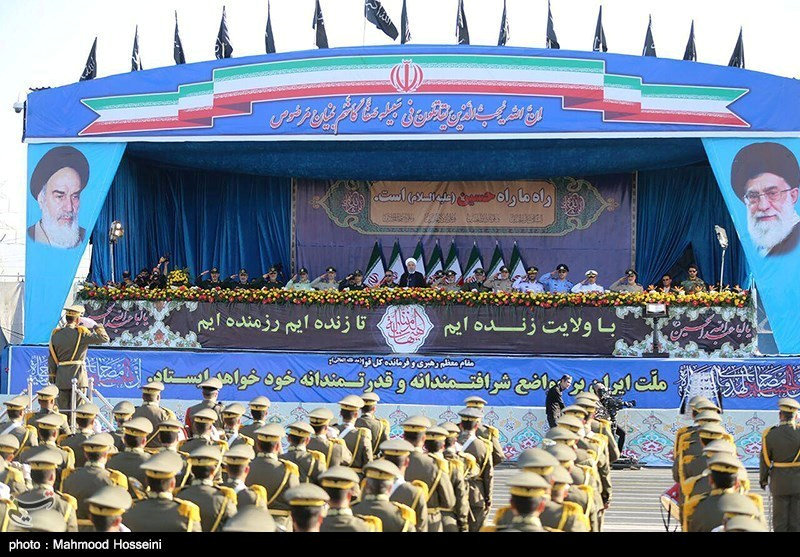Terrorists Attack Iran Military Parade, Killing Dozens
Terrorists disguised as soldiers opened fire Saturday on an annual Iranian military parade in the country’s oil-rich southwest, killing at least 25 people and wounding over 60 in the deadliest terror attack to strike the country in nearly a decade.
Women and children scattered along with once-marching Revolutionary Guard soldiers as heavy gunfire rang out at the parade in Ahvaz, the chaos captured live on state media.
The region’s Arab separatists, once only known for nighttime attacks on unguarded oil pipelines, claimed responsibility for the brazen assault.
Iranian Foreign Minister Mohammad Javad Zarif blamed regional countries and their “U.S. masters” for funding and arming the separatists, issuing a stark warning as regional tensions remain high in the wake of the U.S. withdraw from the Iranian nuclear deal.
“Iran will respond swiftly and decisively in defense of Iranian lives,” Zarif wrote on Twitter.
The attack came as rows of Revolutionary Guardsmen marched down Ahvaz’s Quds, or Jerusalem, Boulevard. It was one of many around the country marking the start of Iran’s long 1980s war with Iraq, commemorations known as the “Sacred Defense Week.”
Journalists and onlookers turned to look toward the first shots, then the rows of marchers broke as soldiers and civilians sought cover under sustained gunfire. Iranian soldiers used their bodies at time to shield civilians in the melee, with one Guardsman in full dress uniform and sash carrying away a bloodied boy.
In the aftermath, paramedics tended to the wounded as soldiers, some bloodied, helped their comrades to ambulances.
The attack killed at least 25 people and wounded over 60, according to the state-run IRNA news agency. It said gunmen wore military uniforms and targeted a riser where military and police commanders were sitting. At least eight of the dead served in the Revolutionary Guard, an elite paramilitary unit that answers only to Iran’s supreme leader, according to the semi-official Tasnim news agency.
“We suddenly realized that some armed people wearing fake military outfits started attacking the comrades from behind (the stage) and then opened fire on women and children,” an unnamed wounded soldier told state media. “They were just aimlessly shooting around and did not have a specific target.”
State media later reported that all four gunmen had been killed, with three dying during the attack and one later succumbing to his wounds at a hospital.
President Hassan Rouhani ordered Iran’s Intelligence Ministry to immediately investigate the attack.
“The president stressed that the response of the Islamic Republic of Iran to the slightest threat would be harsh, but those who support the terrorists should be accountable,” IRNA reported.
Meanwhile, Supreme Leader Ayatollah Ali Khamenei described the attack as exposing “the atrocity and viciousness of the enemies of the Iranian nation.”
“Their crime is a continuation of the conspiracies by the U.S.-backed regimes in the region which have aimed at creating insecurity in our dear country,” Khamenei said in a statement. “However, to their dismay, the Iranian nation will persist on the noble and prideful path they have taken and will — like before — overcome all animosities.”
Tensions have been on the rise between Iran and the U.S. The Trump administration in May pulled out of the 2015 nuclear accord with Iran, and since then has re-imposed sanctions that were eased under the deal. It also has steadily ramped up pressure on Iran to try to get it to stop what Washington calls “malign activities” in the region.
Despite those touchy relations, the U.S. government strongly deplored the attack, saying that “the United States condemns all acts of terrorism and the loss of any innocent lives.”
“We stand with the Iranian people against the scourge of radical Islamic terrorism and express our sympathy to them at this terrible time,” State Department spokeswoman Heather Nauert said.
Initially, authorities described the assailants as “takfiri gunmen,” a term previously used to describe the Islamic State group. Iran has been deeply involved in the fight against IS in Iraq and has aided embattled Syrian President Bashar Assad in his country’s long war.
But later, state media and government officials seemed to come to the consensus that Arab separatists in the region were responsible. The separatists accuse Iran’s Persian-dominated government of discriminating against its ethnic Arab minority, though an Ahvazi Arab, Gen. Ali Shamkhani, serves as the secretary of Iran’s Supreme National Security Council.
Khuzestan province also has seen recent protests over Iran’s nationwide drought, as well as economic protests.
Iran has blamed its Mideast archrival, the Sunni kingdom of Saudi Arabia, for funding Arab separatists’ activity. State media in Saudi Arabia did not immediately acknowledge the attack, though a Saudi-linked, Farsi-language satellite channel based in the United Kingdom immediately carried an interview with an Ahvazi activist claiming Saturday’s attack.
